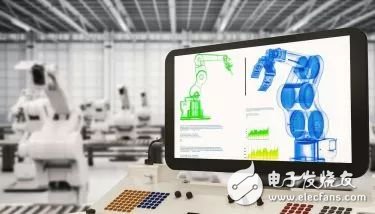"Industry 4.0" seems to be everywhere, and with it comes the terrible warning of falling behind.
Because of fear of falling behind the industry trend, it is easy to fall into a state of paralysis, especially when the industry is undergoing changes.
"Industry 4.0" (the fourth industrial revolution) seems to be everywhere, followed by warnings about the terrible consequences that the British manufacturing industry cannot keep up with its peers. At the same time, new competitors always Every moment will stand out from the (3D printed) wood product manufacturers.
Industry 4.0 will inevitably bring new hope to factories, including reducing operating costs, improving visibility, improving overall equipment efficiency (OEE), and accelerating the speed of new product lines to market.

But similar to early changes, although the process of Industry 4.0 may be transformative, it does not necessarily achieve immediate results, and in fact it is often difficult to win. The fact is that a large part of the initiatives related to Industry 4.0 ended in failure.
In fact, a recent Cisco study showed that only 26% of Internet of Things (IoT) projects are completely successful. The remaining 74% of IoT projects are still in progress, namely delayed projects and completely failed projects (approximately 15%).
If you have not really started the journey of Industry 4.0, please don't panic! You can rest assured that you have not made any costly mistakes. Based on these seven key steps related to digitalization, you can learn from the mistakes of others and avoid repeating the same mistakes.
1. Face realityIt is tempting to try to reorganize your entire business process desperately, especially when you are worried about falling behind the market. However, if you focus on the entire factory, your chances of success will inevitably be greatly reduced.
Try to start with a small project in a key area, which may be the area with the longest downtime, the most maintenance, and the highest energy consumption. Start with a specific and measurable direction.

Unlike focusing on the entire factory, this may be the ultimate goal, try and maintain the manageability of the project.
Maintain project manageability. Rather than focusing on the entire plant, this may be the ultimate goal. Perhaps it is more appropriate to focus on introducing location-based services to better manage your assets, and then start upgrading from here.
It is important to consider how to scale. If you are successful, what should you do next? Although "avoid being paralyzed by worrying about the level of digitization" is very important, you also want to avoid creating a false sense of security in yourself. In fact, you already ticked the "Industry 4.0" box at the beginning and fell into the trap of "Industry 4.0".
2. Know what success looks likeThis article lists some of the latest trending terms, which can allow some calm-headed professionals to directly understand some cutting-edge information without careful preparation in the past. Regardless of the relevance of Industry 4.0, fear or enthusiasm is not a reason to dive directly into the industry 4.0 megatrend without setting clear goals, objectively or fully understanding the return on investment (ROI).
Determine what you are trying to achieve, then measure before and after any Industry 4.0 project. For example, how long is your unplanned downtime today? Where do you want to proceed? Till when?
Digitizing operations with the same level of rigor as other strategic investments or process improvements will ensure that you consider all relevant matters when deciding whether to invest time and effort—and you can say with certainty whether it is worth it.
3. Based on technologyThe description is obvious, but only with the right technology can the manufacturing process be linked. Not only do you need to master new toolkits and software to realize the many benefits promised by Industry 4.0, you also need to understand IoT technology, and professionals who have successfully and safely executed such projects before.
Your internal IT department, supplier or outsourcing IT provider should have important expertise in orchestrating data flows during operations and trade, or be able and willing to recognize gaps in their knowledge and experience.
Interacting with them early and getting them involved in your plan is crucial, not after you order equipment and redesign the production line.
4. There is no "operation (O)" or "information technology (I)" in the "team"
The wave of data originating from the factory will require data analysis, which may bring new computing requirements. Image source: Depositphotos
The days when operations were separated from IT and smoothly implemented network-related technology projects are gone, or at least almost disappeared. Close cooperation can increase the chance of success.
For example, a wave of data originating from factories will require data analysis. This may bring new computing requirements, and this is where IT will play a role. But it may also bring new security risks-this is that only by fully understanding the operational requirements, IT can play a role in key areas.
You need not only related IT, but also the approval of the entire leadership team. This can help you provide support throughout your organization and ensure that your Industry 4.0 initiatives are aligned with corporate goals such as sustainability or safety. In addition, through adjustments, you may find supporters in unexpected quarters.
5. Understand and resolve security risksAssociating data from the factory with other businesses, or opening up remote access right to the factory level may pose security risks. When working on any digital manufacturing project, your attack surface may expand. This is where operations and IT collaboration can bring great value to your organization.
Carefully evaluate potential risks and the impact of those risks, and then focus on the most serious risks. You may not be able to solve all these problems immediately, but you can and should find a trusted partner to conduct a security assessment to help you assess the risk and determine the risk level.
Recently, high-profile ransomware attacks targeting the manufacturing industry have shown that if hackers rampage, operational risks will stagnate. The threat is real-don't let the opportunity be insecure.
6. Avoid data overloadAlthough you can connect almost everything and everyone to the Internet, you can delete content that actually needs to be connected.
For example, if you are interested in improving the product quality of a certain production line, don't overload the data. Keep the data set in a manageable state, and use basic statistical analysis to find abnormal data.
In addition, you can also consider using edge analysis ("cloud computing") to reduce the amount of data for subsequent analysis. Cooperate with suppliers or partners who have extensive experience in "analysis software dedicated to viewing manufacturing data and collecting actionable results from relevant levels of detailed analysis when effective data is of high value to you."
Otherwise, please keep it as simple as possible, and operate according to your needs and current or mid-term situations that may require actual use.
7. Know your limits
Regardless of the scale of your manufacturing business, the digital path may be a path you have never imagined before. One of the key concerns of the British government is the digital skills gap. Therefore, if you and your team are currently extremely lacking in skills or experience to control Industry 4.0 with confidence, this problem is entirely possible.
But don't panic. Put your current ability into the required field, and the first step may be to find out the ability you don't have!
Regardless of whether your resources are internal resources or resources obtained from suppliers or outsourcing providers, start with technology and HR, and deal with the topic rationally and consciously. Work together to identify gaps and identify areas where you need external advice.
Although the prospect of paid advice may be unattractive, especially in the case of additional investment, it is often cheaper to get the correct opinion early. Therefore, you can plan to improve your skills, or hire or contract related professional consultants in the most appropriate way Fill the gap.
You want a change that marks the beginning of a successful transformation, not an overnight coup, or a worse ending-a failed coup. The better the plan on "how to avoid potential obstacles to Industry 4.0", the easier it will be to alleviate these obstacles when inevitable.
In Industry 4.0, manufacturers either do it well or insist on doing it. Which plan will you choose?
Shaded Pole Motor,Capacitor Motor Yc Series,Capacitor Motor Tl61,Shaded Pole Ac Motor
Wentelon Micro-Motor Co.,Ltd. , https://www.wentelon.com